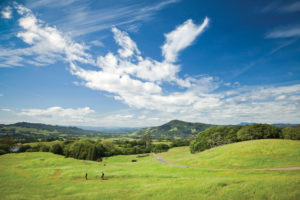Rather than performing plays, Word for Word performs short works of fiction, verbatim. As part of Cal Performance’s “First Stage for Families” program, designed to introduce children to theater, they will workshop “Stories from Sonoma Mountain” by Native American author Greg Sarris.
Plants, animals, arachnids and the landscape itself come alive as their spirits speak. Coordinating this creative venture, Word for Word director Nancy Shelby has great love and respect for Sarris and his work.
Q: How did you develop an interest in Sonoma Mountain?
Shelby: Through Greg Sarris, who is a contributor to Bay Nature and has become a friend. He moved back to the Bay Area and lives on Sonoma Mountain. He did a fundraiser for us at his house. I was aware of the Sonoma and Napa valleys, but through Greg I got to know the history, legends, and beauty of Sonoma Mountain.
Q: How do the actors prepare? Do you go on field trips?
Shelby: It wasn’t in our budget. But the choreographer, Andrea Webber, and I had a dinner with Greg several years ago. He’s such an amazing storyteller. He told us numerous stories. We’re performing two, “How Water Bug Stole the Water” and “How Tom Smith Caused the 1906 Earthquake.”
Word for Word had commissioned a children’s story by Greg, “How Tom Smith Caused the 1906 Earthquake.” He had never written for children before. Because he had such a good time, and because he was living on the mountain and remembering all the stories that he had heard as a young person, he decided that he would write a collection about the animals, the lizards, the insects, the elements, the fog, the creeks – all of whom have a spirit and a song, which is a connection with their inner power.
Andrea and I asked the actors to observe the animals that they are playing. There are 18 different creatures in our performances. We asked them to observe the animals in nature or to look on YouTube (if they didn’t have access to water bugs or bobcats). And then to create a signature gesture and a way of holding the body that expresses the essence of that animal; and then to create a way of moving, the way that they move in their environment.
And then, of course, we’ve suggested that they make their own trip to Sonoma Mountain.
Q: Do you consider yourself an environmental theater artist, or a theatrical environmentalist? Or neither?
Shelby: Hmm… The history of theater goes back to the campfire and the village coming together purposefully, and someone stepping into the center of that circle, close to the fire, and reflecting back to the group what it means to be human. I most enjoy pieces that are intensely about what is important about a human being.
I keep coming back to Greg’s work because I know that it’s a teaching tool. It’s worth our time in creating the piece, and it’s worth the time of the audience members who honor us with assembling to have something reflected to them. To know that our audience is primarily children, it’s a signal to us to do some fun things. And we have the honor and the opportunity to share some of the Native American wisdom about living in harmony with nature.
Q: There can be a tension between “art and the artificial” and “nature and the natural”. How do you create natural art?
Shelby: Artifice and language are what we have to communicate about nature. What else is there? There is sharing a direct experience. But then what? You can be silently together in nature? That would be an authentic way of connecting with nature that doesn’t involve artifice and language. Until you go, “Look at that!”
And then there’s language. With these stories, we’re replicating magic. And there are lessons to be learned.
Q: What is your favorite hike in the Bay Area?
Shelby: In Berkeley, the fire trail up above the labs way high above the campus. When I was living there, and I had a young dog, and I was running quite a bit, that was a place where I went several times a week. It was so beautiful. It was my mysterious, into-the-heart-of-nature place.
Note: Word for Word is seeking funding for a full production of “Stories from Sonoma Mountain.”

.jpg)
